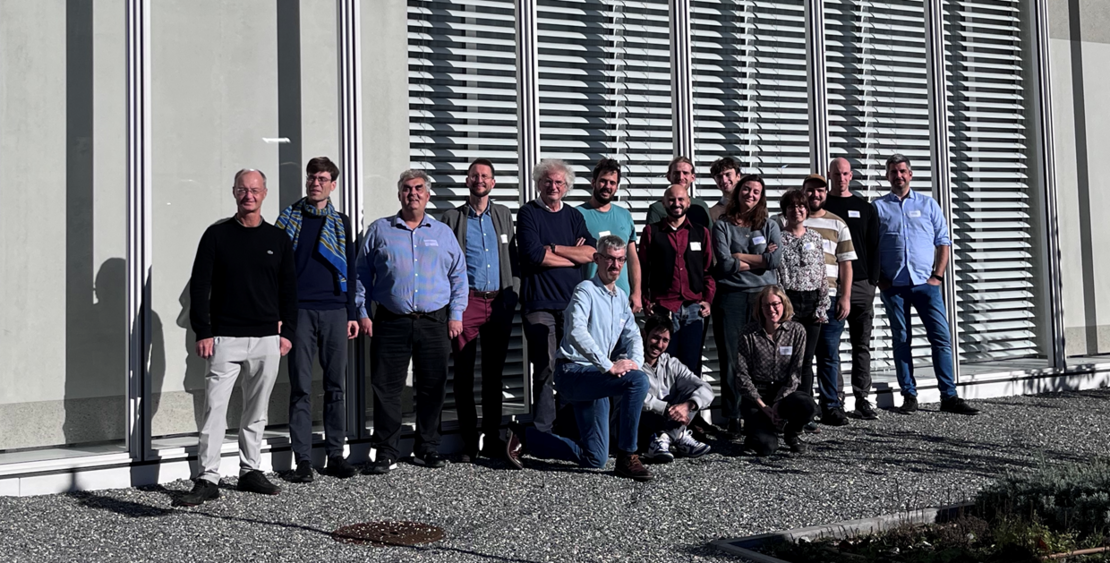Séance d'information - CAS Protection des données
Online

The fall meeting of the Swiss Mathematical Society takes place on the UniDistance Suisse Campus in Brig in the form of a Geometry Day. Everyone is welcome to attend, but please register by October 23rd using the form below.
For any questions, please contact thomas.mettler@fernuni.ch.
In partnership with

| 10:30 - 11:00 | Welcome & Coffee |
| 11:00 - 11:50 | Stefan Wenger |
| 12:00 | Lunch on Campus |
| 13:10 - 14:00 | Anton Alekseev |
| 14:10 - 15:00 | Frank Kutzschebauch |
| 15:00 - 15:30 | Coffee Break |
| 15:30 - 16:20 | Claire Burrin |
| 16:30 - 17:20 | Peter Feller |
| 18:00 | Dinner |
In this talk, we use the definition of Teichmüller spaces as spaces of hyperbolic metrics on 2-surfaces modulo the connected component of the diffeomorphism group. By the classical results of Weil, Peterson and Wolpert, a Teichmüller space of a closed surface carries a canonical symplectic structure. We will recall the two descriptions of this structure using Fenchel-Nielsen twists and using flat connections. We will then explain how this construction generalizes to infinite dimensional Teichmüller spaces corresponding to surfaces with absolute boundaries. On the way, we will recall the notion of symplectic reduction which is one of the main tools to be used in the talk.
The presentation is based on a joint work in progress with Eckhard Meinrenken. The motivation for this work comes from recent developments in the theory of Jackiw-Teitelboim quantum gravity in theoretical physics.
I will discuss a recent paper with Flemming von Essen, where we consider explicit realizations of the winding of closed geodesics about a prescribed cusp of a given hyperbolic surface. For a class of surfaces (containing arithmetic surfaces), our construction can be exploited by the spectral theory of automorphic forms to produce statistical results for the winding numbers. I will in particular present the following equidistribution result: for any subset A of the integers with natural density d, the proportion of closed geodesics with number of windings in A is asymptotically equal to d.
In his celebrated disquisitiones arithmeticae, Gauss studied a composition law on integral binary quadratic forms. The resulting group, aka the class group of quadratic field extensions of Q, has been intensely studied in algebraic number theory.
In joint work in progress with Akka, Miller, and Wieser, we use this group to address a problem of constructing pairs of genus 1 surfaces with boundary the same knot in S^3 with the property that they are non-isotopic and remain so, when pushed into the 4-ball. Among other things we are able to provide larger context to a 40-year old question by Livingston and recent examples of such surfaces due to Hayden, Kim, Miller, Park, and Sundberg.
The relevant input from number theory turns out to be Bhargava's stunning recasting of Gauss's composition as a cube law.
By the classical uniformization theorem, every smooth 2-dimensional sphere admits a conformal diffeomorphism from the standard Euclidean sphere. Recent advances in the field of Analysis on metric spaces have allowed to extend this theorem to a non-smooth setting of metric spheres (i.e. metric spaces homeomorphic to the 2-dimensional sphere) with some additional properties. Landmark results in this direction include the Bonk-Kleiner quasisymmetric uniformization theorem and Rajala's characterization of geometrically quasiconformal spheres. The search for uniformization results in a metric setting has partially been motivated by questions from geometric group theory. In this talk, I will first provide some background and motivations and then present a general uniformization theorem which shows that one can still find a weakly quasiconfomal parametrization for metric spheres when only assuming that they are locally geodesic and have finite area. Under suitable extra hypotheses such a parametrization upgrades to a quasisymmetric or quasiconformal map and we thus recover as special cases the above mentioned results of Bonk-Kleiner and Rajala. Based on joint work with Damaris Meier.
| Abramyan Semyon | ETH Zürich |
| Alekseev Anton | University of Geneva |
| Baader Sebastien | University of Bern |
| Burrin Claire | University of Zürich |
| Desarzens Stéphane | University of Bern |
| Feller Peter | ETH Zürich |
| Flood Keegan | UniDistance Suisse |
| Huang Gaofeng | University of Bern |
| Jörg Jasmin | University of Bern |
| Kutzschebauch Frank | University of Bern |
| Le Donne Enrico | University of Fribourg |
| Loeffler David | Warwick / UniDistance Suisse |
| Meier Damaris | University of Fribourg |
| Mettler Thomas | UniDistance Suisse |
| Popova Iuliia | University of Geneva |
| Schnieper Nicolà | University of Bern |
| Valette Alain | Université de Neuchâtel |
| Vikman Noa | University of Fribourg |
| Wenger Stefan | University of Fribourg |
| Zerbes Sarah | ETH Zürich |
| Zulian Patrick | UniDistance Suisse |
